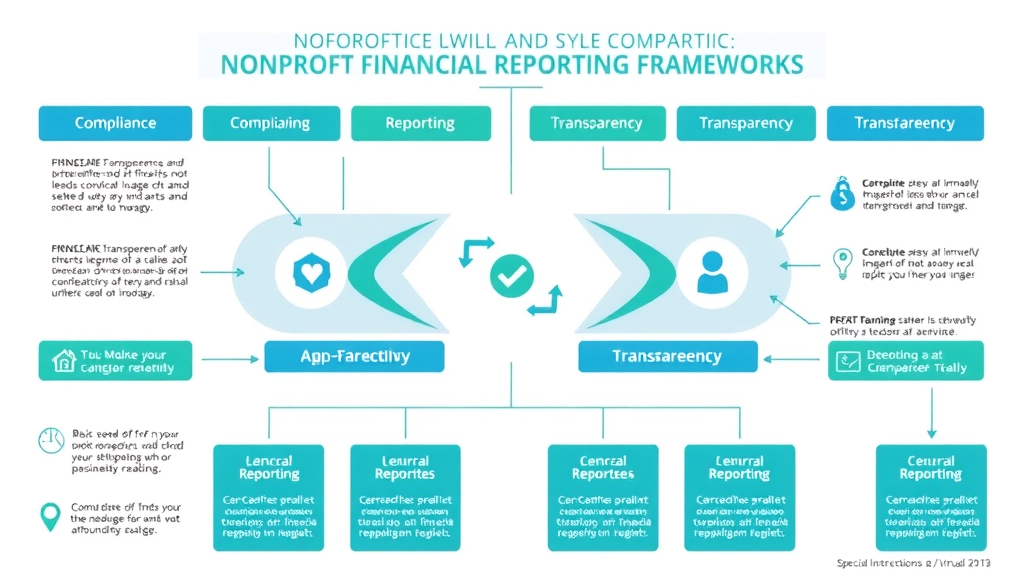Did you know that more than 40% of nonprofits operate on razor-thin margins because of gaps or errors in their financial reporting? While most organizations focus on serving their missions, the truth is that nonprofit financial reporting can be the silent force that either accelerates your impact or undermines your sustainability. In this educational guide, discover why mastering nonprofit financial reporting is not just an administrative necessity—it could be the critical factor that ensures your organization’s survival and growth.

A Surprising Reality: Why Nonprofit Financial Reporting is Crucial for Survival
The success and longevity of any nonprofit organization hinge on much more than heartfelt missions and community engagement. Nonprofit financial reporting sits at the center of financial health, transparency, and accountability, directly impacting public trust, donor confidence, and compliance with legal requirements. Without robust financial statements and clear financial information, nonprofits risk missing key opportunities for funding or, worse, exposing themselves to devastating errors that can threaten their existence. For many organizations, the difference between thriving and mere survival often rests on the accuracy and clarity of their financial reporting practices.
It's easy to overlook the importance of disciplined financial management when you’re caught up in program delivery and mission execution. However, nonprofit board members, staff, and stakeholders must realize that clear, precise, and compliant financial statements are foundational. They tell your nonprofit’s story to funders and regulatory bodies, influence strategic decisions, and act as red flags or green lights for future endeavors. Neglect in this area isn’t just an oversight—it’s a risk that can unravel years of hard work, damage relationships, and even jeopardize tax-exempt status.
The Stark Truth Behind Nonprofit Financial Statement Data
Looking closely at the data, many nonprofit organizations struggle to maintain even month-to-month stability. Financial activities such as tracking cash flow, monitoring expenses, and reporting on net assets can make the difference between formal transparency and operational ambiguity. Misreporting or incomplete disclosures drive away funders who rely on financial reports to evaluate financial performance and organizational effectiveness. Neglected financial statements can broadcast red flags—irregular spending, unauthorized deficits, and cash shortfalls—which deter donors and compromise the very mission nonprofits serve to uphold.
"More than 40% of nonprofits operate on razor-thin margins due to gaps in financial reporting – National Council of Nonprofits."
With this stark reality in mind, prioritizing disciplined and accurate nonprofit financial reporting is not just best practice—it’s a survival strategy. Even the most well-intentioned organizations can falter without strong financial oversight, clear statements of activities, and a system for regular review and improvement.
What You'll Learn: Mastering Nonprofit Financial Reporting for Lasting Impact
- Key components of nonprofit financial reporting
- Best practices for financial statement creation
- Common pitfalls in nonprofit financial statements
- How to interpret and act on financial report data
Understanding Nonprofit Financial Reporting: Foundations and Frameworks
Defining 'Nonprofit Financial Reporting' in Today's Regulatory Landscape
Nonprofit financial reporting refers to the standardized process by which nonprofit organizations disclose their financial activities, resources, and obligations. In today’s evolving regulatory landscape, this process is far more than just recordkeeping—it is central to organizational credibility, public trust, and legal compliance. As nonprofits navigate changing standards and increased scrutiny—from donors, the IRS, and accrediting bodies—the need for consistent, transparent, and accurate financial information has never been greater. By adhering to frameworks such as FASB (Financial Accounting Standards Board) and GAAP (Generally Accepted Accounting Principles), nonprofits ensure that their financial reports are both compliant and reliable.
Transparent reporting is a vital part of ensuring legitimacy and ongoing support. Stakeholders, from board members to funders, look at financial statements to assess stewardship of donated assets and evaluate the efficiency of service delivery. In this high-stakes arena, any lapse in compliance or clarity can quickly lead to questions, loss of donor confidence, or even regulatory penalties. Understanding the distinction between different types of financial information and how it must be reported is thus essential for all nonprofit leaders.

The Role of the Financial Statement in Transparent Operations
Central to nonprofit transparency and accountability are the organization’s financial statements. These documents—including the statement of financial position, statement of activities, and statement of cash flows—provide a snapshot of financial health and operational stability. When prepared accurately, a nonprofit financial statement enables board members, auditors, and stakeholders to track assets, assess liabilities, and measure net assets over time, all of which are essential for making strategic decisions and meeting compliance requirements.
Transparent financial reporting goes hand in hand with the trust that allows organizations to attract major funding, build partnerships, and inspire the communities they serve. Without transparent reporting, questions arise about the use of funds, the division between program and overhead expenses, and the overall efficiency of the nonprofit. Establishing and maintaining clear, timely, and accurate reports is not just about meeting legal demands—it’s about reinforcing the integrity of your entire organization.
Financial Information vs. Financial Reports: Key Distinctions
It’s vital to distinguish between raw financial information and formal financial reports. Financial information comprises the data behind the scenes: transaction records, receipts, payroll logs, and more. Conversely, financial reports translate this vast web of numbers into structured documents—think balance sheet, statement of functional expenses, and annual report—offering an accessible and comprehensive view of financial activities to non-expert stakeholders. The process of transforming financial information into financial reports requires strict adherence to reporting standards to ensure completeness, accuracy, and comparability over time.
Failing to organize and present financial information properly can result in incomplete financial statements, misunderstood program costs, or even inadvertent noncompliance. By appreciating these distinctions and crafting high-quality, comprehensive financial reports, nonprofits can provide clarity, foster trust, and support better decision-making across their organization and donor community.
Core Elements of a Nonprofit Financial Statement
Statement of Financial Position: Assessing Financial Health
The statement of financial position—the nonprofit equivalent of a balance sheet—is a foundational financial report. It summarizes what your organization owns (assets), what it owes (liabilities), and what is left over (net assets) at a specific point in time. This document is critical for evaluating both short-term stability and long-term sustainability. Board members and funders routinely analyze the statement of financial position to determine if your nonprofit has the resources to cover debts, withstand financial blows, and take advantage of growth opportunities. Weak positions here can be an early warning sign of deeper structural or operational issues.
Assets are typically broken down into immediate resources (like cash and receivables) and longer-term holdings (property or investments). Liabilities might include outstanding bills and future obligations. Net assets, representing the difference, reflect the true value and flexibility of the nonprofit. Regular review of this statement is essential to operational planning, fulfilling fiduciary duties, and taking timely corrective actions when necessary, thereby safeguarding organizational health for years to come.
Statement of Activities: Tracking Revenue and Expenses
Think of the statement of activities as the nonprofit’s version of an income statement. It details revenues (such as grants, donations, and service income) and their corresponding expenses, breaking them down over a given period. By highlighting how much money flows in versus how much is spent—and on what—the statement of activities offers invaluable insights into funding sufficiency, program effectiveness, and fiscal management.
This financial report is instrumental for leadership, funders, and auditors to spot trends, monitor progress toward goals, and adjust strategies as needs change. Fluctuations or unexpected patterns within the statement of activities can reveal both opportunities (such as growing donation streams) and challenges (emerging deficits or escalating costs), thus informing data-driven decisions and future fundraising strategies.
Statement of Functional Expenses: Ensuring Accountability
The statement of functional expenses is unique to nonprofits and provides a detailed breakdown of how funds are allocated across program activities, management, administrative functions, and fundraising efforts. This degree of specificity ensures accountability and transparency, assuring donors and regulators that contributions are directed to intended purposes and that overhead costs remain reasonable. This report is crucial in guarding against “mission drift”—the tendency to spend disproportionately on administration or fundraising at the expense of core programs.
Funders and watchdog organizations examine this statement to see if your nonprofit maintains the right balance between core mission work and support activities. A healthy ratio increases fundraising appeal and supports compliance with IRS guidelines and best practices. Consistent, transparent use of a statement of functional expenses can mean the difference between nonprofit financial reporting that inspires confidence versus skepticism or doubt.
Statement of Cash Flows: Revealing Operational Viability
Finally, the statement of cash flows tracks the movement of cash into and out of the organization across operating, investing, and financing activities. Unlike accrual-based statements, this financial report focuses strictly on tangible cash movement, delivering an “at-a-glance” understanding of liquidity and operational viability. Positive cash flows indicate a healthy position to meet obligations and fund critical initiatives, while negative flows may signal the need for immediate action.
Analyzing this statement enables nonprofits to anticipate cash crunches, manage investments, and make informed spending decisions throughout the year. If there’s a gap in expected and actual cash flow, this report makes it clear, empowering leaders to address problems before they threaten mission delivery or organizational survival.
| Statement | Main Focus | Key Audience | Critical Insight |
|---|---|---|---|
| Statement of Financial Position | Assets, liabilities, net assets | Board, auditors, funders | Measures liquidity and long-term strength |
| Statement of Activities | Revenue, expenses over time | Leadership, funders | Tracks growth, funding needs |
| Statement of Functional Expenses | Expense allocation by function | Donors, IRS, watchdogs | Assesses mission spending vs. overhead |
| Statement of Cash Flows | Cash inflows & outflows | Managers, board | Evaluates financial operations & risk |
Financial Reports for Nonprofit Organizations: Types and Importance

Annual Report vs. Financial Statement: Scope and Audience
The annual report and the financial statement are both essential but serve distinct purposes. An annual report is a narrative document showcasing the nonprofit’s achievements, goals, impact stories, and summarized financial data for the year. It's crafted for broad audiences—donors, clients, the public—to inspire, inform, and build community engagement. In contrast, financial statements are factual, standardized reports intended primarily for board members, funders, auditors, and regulators who require detailed financial information for oversight and decision-making.
While your annual report can draw people in and boost your profile, it’s the clarity, integrity, and detail of your formal financial statements that truly earn trust and open doors for major grants, endowments, and partnerships. Having strong, auditor-ready statements embedded within compelling annual reports achieves both compliance and storytelling objectives—critical for any nonprofit organization aiming for sustainable success.
How Nonprofit Financial Reports Influence Donor Confidence
Donors—whether individuals, foundations, or corporate partners—rely on clear, honest, and comprehensive nonprofit financial reports before making funding decisions. Accurate reporting closes the confidence gap, showing precisely how previous contributions have been utilized, revealing growth trends, responsible spending, and strong financial stewardship through clear cash flow and net asset information. Frequent, credible reporting can strengthen long-term donor relationships, while ambiguous or delayed statements erode trust and opportunities for future giving.
This dynamic has become even more pronounced in an age where the impact and efficiency of every dollar spent is scrutinized. Organizations that proactively provide well-organized, transparent financial reports are far more likely to be viewed as reliable partners by funders, increasing their chances to access larger grants and develop enduring funding streams. In essence, robust nonprofit financial reporting is the foundation of sustainable fundraising and organizational growth.
Internally vs. Externally Focused Financial Reporting
Internal financial reporting involves documentation and data analysis designed to support daily operational decisions, budget management, and strategic planning for nonprofit leadership. These reports are often more detailed, focusing on segments like department spending, cost centers, and cash reserves needed for ongoing programs. Externally focused reports—crafted for donors, regulators, and the public—place an emphasis on compliance, aggregate numbers, and storytelling that supports transparency and legitimacy.
Organizations must strike a balance between the granular, up-to-date information needed for internal effectiveness and the standardized, accessible reports required for external audiences. Mastering both is essential for holistic nonprofit financial management and for building resilient relationships with the communities, donors, and oversight bodies you serve.
Best Practices in Nonprofit Financial Reporting
Implementing Consistent Financial Reporting Policies
Achieving excellence in nonprofit financial reporting requires more than periodic documentation—it demands institutionalized best practices. First, adopt standardized templates for all financial statements and reports, ensuring consistency across time periods and facilitating easier comparison and auditing. Next, schedule regular internal audits to catch errors, confirm accuracy, and reinforce compliance with GAAP, FASB, and IRS requirements. Finally, integrate secure, user-friendly technology platforms to centralize financial information and automate workflows, significantly reducing the chances of human error and data entry problems.
With policies and platforms aligned, organizations gain a comprehensive, real-time view of their finances, improving the quality of reporting, expediting decision-making, and minimizing risk. These practices also position nonprofits to respond confidently to inquiries, seize new funding opportunities, and foster a culture of financial responsibility at every organizational level.
- Adopt standardized templates for all nonprofit financial reports
- Schedule regular internal audits
- Integrate technology platforms for data integrity
How to Avoid Common Financial Statement Errors
Even minor mistakes in nonprofit financial statements can have outsized consequences. To avert issues, it’s essential to train all staff involved in financial transactions, establish standardized data entry and review procedures, and implement a routine double-check system before reports are finalized and distributed. Many errors stem from misunderstanding reporting requirements, misclassifying revenue or expenses, or overlooking reconciliation between bank statements and internal records. Developing clear checklists and documentation procedures dramatically reduces the risk of costly missteps.
"A single error in a nonprofit financial statement can undermine years of trust."
Organizations should also commit to continuous learning, keeping up with evolving compliance standards and adopting tools that flag inconsistencies or anomalies automatically. By treating nonprofit financial reporting as a living process—adaptable, teachable, and routinely reviewed—your organization dramatically bolsters accuracy, accountability, and sustainability.
Navigating Nonprofit Financial Reporting Requirements

Regulatory Standards for Nonprofit Accounting and Reporting
Nonprofit organizations must comply with a complex web of regulatory requirements. Standards set by the FASB and GAAP govern how financial information is collected, reported, and audited. Adhering to these frameworks ensures that financial reports are uniform, credible, and comparable—regardless of organizational size or mission. Many states have their own additional requirements, often tied to charitable solicitation laws or grant contracts, mandating extra disclosures and periodic reporting to maintain good standing.
Failure to comply can bring significant consequences—from loss of public charity status and funding forfeiture to legal action or reputational harm. For this reason, nonprofit financial reporting must be proactive, methodical, and continuously updated to reflect changes in both operational scope and regulatory expectations.
IRS Reporting Requirements and the Annual 990 Filing
The Internal Revenue Service (IRS) requires nearly all tax-exempt organizations to file Form 990 annually. This comprehensive report includes detailed information on financial activities, governance, executive compensation, program accomplishments, and more. Failure to file Form 990 or meet its requirements can result in hefty penalties, automatic revocation of tax-exempt status, and public censure. Thus, filing an accurate and timely 990 is a non-negotiable cornerstone of responsible nonprofit financial reporting.
For nonprofits, the annual 990 is also a major transparency tool, as it is publicly accessible and increasingly reviewed by donors and watchdog groups. Incomplete or inaccurate filings can raise red flags for anyone researching your organization’s financial performance or social impact, so attention to detail and compliance with all filing instructions is critical year after year.
Nonprofit Financial Reporting: FASB, GAAP, and Compliance
Financial reporting for nonprofits must align with dual standards: the Financial Accounting Standards Board (FASB) and the Generally Accepted Accounting Principles (GAAP). These frameworks dictate the structure, content, and consistency of financial statements, ensuring comparability across the nonprofit sector. Following these standards builds investor and public trust by signaling professionalism, accuracy, and a commitment to rigorous stewardship of funds.
This is especially vital in grant reporting, government contracts, and larger fundraising efforts where transparency and compliance are scrutinized. Failure to align nonprofit financial reporting with recognized standards can result in disqualified grant applications, delayed funding, audits, or penalties—risks that can be easily avoided by integrating these frameworks into all aspects of your financial management process.
Understanding the 33% Rule for Nonprofits
One of the most important—and often misunderstood—compliance benchmarks for public charities is the “33% rule.” To qualify as a public charity under IRS rules, a nonprofit must receive at least one-third of its support from public sources—grants, individual gifts, or government funds. This threshold is central to maintaining tax-exempt status and shapes how nonprofits approach fundraising, donor reporting, and grant applications.
Failing to meet the 33% rule can reclassify an organization as a private foundation, introducing a host of administrative burdens and restrictions. Meticulous nonprofit financial reporting is required to track, demonstrate, and maintain compliance with this rule at all times—making it a vital consideration for all staff and board members involved in financial activities.
| Requirement | Form/Report | Frequency | Deadline |
|---|---|---|---|
| IRS Annual Filing | Form 990/990-EZ/990-N | Annually | 15th of 5th month after fiscal year ends |
| State Charitable Registration | Varies by state | Annually | Varies |
| Board Financial Review | Financial Statements | Quarterly/Annually | Set by board policy |
| Grant/Funder Reporting | Custom Reports | Ongoing | As required by contract |
Evaluating Nonprofit Financial Statements: What to Look For

Assessing Financial Health from Nonprofit Financial Statements
Determining the financial health of your nonprofit requires a holistic, analytical review of all key financial statements. Start by analyzing the statement of financial position to evaluate liquidity and solvency—does your organization have sufficient assets to cover its obligations? Then, evaluate the statement of activities for consistent revenue streams and manageable expenses, ensuring program spending aligns with your mission and budget. The statement of functional expenses should reveal efficient allocation to core programs, keeping overhead within sector benchmarks.
A close look at the statement of cash flows provides a reality check on your organization’s ability to meet short- and long-term resource needs. This process helps board members and leadership teams uncover potential vulnerabilities, spot financial performance trends, and ensure that strategic adjustments can be made to sustain mission-driven work well into the future.
Key Ratios and Indicators: Cash Flow, Functional Expenses, Net Assets
To dig deeper, use specific financial ratios and indicators for a clearer assessment. The operating reserve ratio (unrestricted net assets divided by monthly expenses) highlights your ability to withstand income disruptions. The program expense ratio measures the percentage of total expenses devoted to core program activities—generally, higher ratios are seen as positive by donors. Cash flow ratios show your current and quick liquidity positions, signaling whether you’re prepared for surprises or dependent on restricted funds. Additionally, tracking changes in net assets year-over-year can reveal financial trajectories, while monitoring fundraising efficiency ensures sustainability is not coming at the cost of mission drift.
Board members, financial analysts, and auditors often review these ratios as part of ongoing oversight. Strong indicators typically correlate with better fundraising success and broader support from institutional partners, while weak or consistently negative ratios may necessitate corrective action or rethinking of financial management policies.
Signs of Strong or Weak Nonprofit Financial Reporting
Robust nonprofit financial reporting is marked by clarity, timeliness, consistency, and compliance with sector standards. Signs of strength include error-free audited statements, high program expense ratios, regular filing of required forms, and transparent disclosures in financial reports. Weaknesses often show up as unexplained variances in expenses, repeated late or missing filings, and inconsistencies between internal records and formal reports. These deficiencies can undermine fundraising, regulatory compliance, and even legal status if left unaddressed.
Conducting regular internal reviews, adopting best-practice documentation procedures, and maintaining centralized control over all financial information are vital steps toward consistent, high-quality nonprofit financial reporting. Always encourage a culture where questions are welcomed, and improvements are embraced as an organizational win.
- Top red flags in nonprofit financial reports: Unexplained expenses, negative net assets, late/missing filings, frequent corrections to reports
- Positive benchmarks for nonprofits: Consistent year-over-year surplus, high program expense ratio, clean audit opinions, regular board review
Case Study: When Nonprofit Financial Reporting Saves – or Sinks – an Organization
A Success Story: Financial Statement Discipline Leading to Growth

Consider a midsize community education nonprofit that, just three years ago, barely managed to make payroll. Recognizing the mounting risks of informal, ad hoc reporting, leadership overhauled their financial reporting systems: they adopted standardized financial report templates, scheduled quarterly financial reviews, and invested in cloud-based management platforms. As a result, their statement of financial position showed steady net asset growth, cash flows stabilized, and their annual report provided clear evidence of impact for stakeholders. The outcome? Over $750,000 in new multi-year gifts, better staff retention, and a growing reputation as a sector leader in transparency and efficiency.
This turnaround story shows that nonprofit financial reporting isn’t just about compliance—it’s a tool for strengthening credibility and catalyzing mission-driven growth. By taking reporting seriously, this nonprofit gained the agility and confidence needed to expand programs and deepen its relationships across the funding landscape.
A Cautionary Tale: Poor Reporting and Its Consequences
Contrast this with a youth services nonprofit that failed to submit timely Form 990 filings and relied on error-prone manual bookkeeping. Financial statements consistently showed discrepancies, and red flags—including unexplained transfers and negative cash flow—were ignored. The consequence was severe: the IRS revoked the group’s tax-exempt status, foundation funders withdrew support, and the local community lost critical programs. Rebuilding trust is a long, demanding process—one that could have been avoided with disciplined, high-quality nonprofit financial reporting from the start.
"Good nonprofit financial reporting is the backbone of sustainability." – Sector Analyst
For every nonprofit, the risks of overlooking transparent and timely reporting far outweigh the effort needed to get systems right. This tale serves as a powerful reminder that your financial reporting practices truly can make—or break—your mission.
People Also Ask: Expert Answers on Nonprofit Financial Reporting
What are the financial reports for a non-profit organization?
Answer: Nonprofit financial reports typically include the statement of financial position, statement of activities, statement of functional expenses, and statement of cash flows, all of which are essential for assessing financial sustainability.
What are the financial reporting requirements for nonprofit accounting?
Answer: Nonprofit financial reporting requirements vary by jurisdiction but generally include annual IRS Form 990, adherence to FASB and GAAP, and transparent public financial statements for funders and stakeholders.
What is the 33% rule for nonprofits?
Answer: The 33% rule requires that at least one-third of a nonprofit’s support come from public sources to qualify as a public charity, impacting nonprofit financial reporting and IRS classification.
What are the IRS reporting requirements for nonprofits?
Answer: The IRS requires nonprofits to file an annual information return (Form 990), maintain accurate records, disclose compensation, and report on activities and governance.
- How often should a nonprofit update its financial statement? Best practice recommends at least quarterly updates, with internal reviews and annual external audits to ensure ongoing relevance and accuracy.
- What happens if a nonprofit fails to meet financial reporting deadlines? Missing deadlines can result in penalties, loss of tax-exempt status, forfeiture of grant funds, and damaged public reputation—risks best avoided by proactive scheduling and checklists.
- Who audits nonprofit financial reports? Most nonprofits use independent certified public accountants (CPAs) for external audits, while internal audits are performed by staff or board finance committees.
- How can transparency be increased in nonprofit financial reporting? Transparency improves through timely, detailed, and standardized statements shared with all stakeholders, open communication around reporting methods, and publishing key documents regularly online.
Key Takeaways from Nonprofit Financial Reporting
- Strong nonprofit financial reporting is vital for fundraising and compliance
- Regular financial statement reviews prevent future crises
- Transparency in nonprofit financial reports builds trust with stakeholders
Conclusion: Make Nonprofit Financial Reporting Your Organization’s Best Asset
Don’t Gamble with Your Mission – Build Strong Nonprofit Financial Statements Today
Effective nonprofit financial reporting can power your organization’s future—make it your competitive edge, not a liability.
Call to Action: For Guidance, Call me the Chaplain 786-333-5270
Understanding the intricacies of nonprofit financial reporting is essential for maintaining transparency, compliance, and trust with stakeholders. To deepen your knowledge, consider exploring the following resources:
- Nonprofit Financial Reporting: Compliance and Best Practices (expertnonprofits.com)
This article provides a comprehensive overview of the importance of financial reporting in nonprofits, emphasizing transparency, accountability, and adherence to legal standards.
- Nonprofit Financial Statements: Everything You Need to Know (memberclicks.com)
This resource outlines the essential components of nonprofit financial statements, including the Statement of Financial Position, Statement of Activities, Statement of Cash Flows, and Statement of Functional Expenses, highlighting their roles in assessing financial health and ensuring compliance.
By delving into these materials, you’ll gain valuable insights into best practices and key considerations for effective nonprofit financial reporting.
 Add Row
Add Row  Add
Add 




Write A Comment